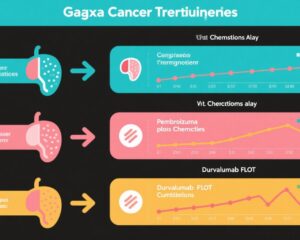Introduction
Marathons have long symbolized endurance, discipline, and health. Millions of runners worldwide undertake this grueling 42.195-kilometer (26.2-mile) challenge every year, inspired by the exercise benefits and the thrill of physical achievement. However, a recent clinical study, presented in abstract form at the American Society of Clinical Oncology (ASCO) meeting in May 2024, has stirred a fresh debate: could frequent, high-intensity long-distance running increase colorectal cancer risk? This question has attracted widespread media attention and public concern, especially after coverage by The New York Times in August 2024.
This article reviews the scientific findings behind this debate, clarifies misconceptions around exercise and cancer risk, and offers practical insights on the health implications of marathon running.
Why Did This Topic Spark Attention?
The study in question emerged from observations by Dr. Timothy Cannon, an oncologist at Inova Schar Cancer Center in Virginia. He noted a troubling rise in colorectal cancer incidence among individuals younger than 50—a demographic previously regarded as relatively low risk. Lowering the recommended screening age for colorectal cancer from 50 to 45 in the U.S. led to more early detections, including in otherwise healthy young runners.
Dr. Cannon was inspired by three younger patients diagnosed with colorectal cancer who were seemingly in excellent health and highly active: two completing ultra-distance marathons (longer than the standard marathon distance) and one competing in numerous half-marathons annually. This observation prompted a clinical study to investigate whether extreme endurance running correlates with an increased prevalence of precancerous lesions.
What Does the Study Reveal?
Between 2022 and 2024, Dr. Cannon’s team enrolled 100 frequent marathon and ultra-marathon runners aged 35 to 50. The strict inclusion criteria required participants to have completed at least two registered ultra-marathons (≥50 km) or five full marathons. These individuals, averaging 42.5 years old with robust fitness levels, underwent colonoscopy screening.
Results showed that 39% had colorectal polyps, mostly benign, but 15% had advanced adenomas—polyps with significant potential to develop into cancer if untreated. In contrast, historical data indicate that advanced adenomas occur in 1.2% of healthy individuals aged 40-49, with a range of 4.5%-6% for those aged 45-50. This suggests a notably higher prevalence among this small, highly selective cohort of intense runners.
Limitations and Cautions in Interpreting the Findings
While the data seem eye-catching, several critical cautions apply:
– Small sample size and lack of control group: The study included just 100 participants from a single cancer center. Comparisons were made only with prior population data, not a matched control group.
– Extremely specialized cohort: These runners represent a tiny fraction of athletes worldwide with exceptionally high training volumes, often far beyond what most people do.
– Possible confounders: The selected runners might have other unique factors affecting polyp prevalence (diet, genetics, medication use) that were not fully controlled.
These factors restrict the generalizability of the study. It is premature to conclude that marathon or ultra-marathon running increases colorectal cancer risk broadly.
Understanding Exercise Dosage and Cancer Risk
Paradoxically, exercise is widely recognized as protective against many cancers, including colorectal cancer. Numerous large epidemiological studies report that regular, moderate physical activity reduces cancer incidence and improves survival among diagnosed patients. The debate centers on the “dose” of exercise—while moderate amounts confer benefits, the effects of extremely high-volume endurance activity have been less studied.
Population data show that most people do far less than even the recommended minimum physical activity levels. For example, in 2024, the average daily exercise time in China was about 35 minutes, while Americans aged 15 and older spent approximately 18.6 minutes (0.31 hours) daily on leisure exercise. This is far from training for marathons or ultra-marathons.
Experts generally recommend at least 150 minutes of moderate or 75 minutes of vigorous aerobic activity weekly, yet about 75% of Americans fail to meet even these minimal guidelines. The theory of an upper threshold exists: benefits plateau with very intense, prolonged exercise.
Health Risks of Marathon and Ultra-Marathon Running
Apart from cancer concerns, marathon-level endurance exercise entails some documented health risks:
– Cardiovascular stress: Acute ultra-endurance races can transiently alter heart structure and function, though effects typically reverse within weeks. Chronic extreme training in elite athletes may pose risks that warrant further investigation.
– Kidney injury: Studies found that 34%-85% of ultra-marathoners develop acute kidney injury during races, primarily due to dehydration and electrolyte imbalance, usually resolving within 48 hours.
– Drug interactions: Nonsteroidal anti-inflammatory drugs (NSAIDs) like ibuprofen may increase kidney damage risk when used during endurance events. Alternatives like acetaminophen may be safer.
– Increased skin cancer risk: Prolonged outdoor exposure raises ultraviolet (UV) radiation exposure, urging runners to adopt rigorous sun protection strategies.
A Fictional Patient Scenario: Meet Laura
Laura, a 44-year-old marketing executive and avid runner, completes one marathon per year and jogs regularly for fitness. She read recent news about marathon running increasing colorectal cancer risk and felt concerned about her training habits.
After discussing with her physician, Laura was reassured that her moderate exercise level backs strong cancer risk reduction, matching extensive scientific consensus. The doctor emphasized routine colorectal screening per guidelines due to her age but clarified the preliminary study targeting extreme runners does not apply to her.
Laura continues to enjoy running with renewed confidence, reinforcing how individualized risk assessment and evidence-based guidance are key.
Expert Insights and Recommendations
Dr. Timothy Cannon underscores that the pilot study is an early step toward understanding the relationship between extreme endurance exercise and gastrointestinal health. “Our findings highlight a signal worthy of larger, controlled studies,” he says, adding, “Most people should not fear regular exercise.”
Leading cardiovascular experts affirm the overall benefits of physical activity vastly outweigh risks, advising people to tailor exercise intensity to personal health status and consult healthcare providers if new symptoms emerge.
The American Cancer Society and other authoritative bodies continue to promote regular physical activity as a cornerstone of cancer prevention.
Correct Health Practices for Runners
– Engage in regular moderate-intensity aerobic exercise (>150 minutes weekly) for overall health gains.
– For those involved in long-distance running, ensure adequate hydration and electrolyte replacement during events.
– Avoid NSAIDs during races; prefer acetaminophen if needed.
– Practice thorough sun protection including sunscreen, hats, and clothing.
– Maintain scheduled cancer screenings appropriate to age and risk factors.
– Listen to your body; seek medical advice for persistent pain, fatigue, or gastrointestinal symptoms.
Conclusion
While a small, preliminary study suggests a higher prevalence of colorectal polyps in a very specialized group of extreme marathon runners, this finding cannot be extrapolated to the general population. Moderate physical activity remains a proven, powerful strategy for reducing cancer risk and improving overall health.
The recent media attention highlights the need for caution in interpreting early research and the importance of balanced health messaging. Most individuals should feel encouraged to stay active, tailoring exercise to their fitness levels and enjoying the many benefits of physical movement.
Further large-scale, controlled studies are needed to explore any potential risks associated with ultra-endurance sports and colorectal health. Meanwhile, the mantra stands firm: run because it brings joy and health, but be mindful and informed.
References
– Cannon T et al. “Prevalence of advanced adenomas in frequent marathon and ultra-marathon runners aged 35-50.” ASCO 2024 Annual Meeting Abstract.
– American Cancer Society. Physical Activity and Cancer Prevention. [https://www.cancer.org/]
– U.S. Bureau of Labor Statistics. American Time Use Survey (ATUS) 2024. [https://www.bls.gov/charts/american-time-use/activity-leisure.htm]
– CEIC Data on Chinese Sports and Fitness Time Use 2024. [https://www.ceicdata.com/en/china/residents-average-daily-time-use/cn-residents-average-daily-time-use-major-activity-categories-sports-and-fitness]
– Stanford Medicine News. “Pain reliever linked to kidney injury in endurance runners.” July 2017. [https://med.stanford.edu/news/all-news/2017/07/pain-reliever-linked-to-kidney-injury-in-endurance-runners.html]
– Yale Medicine News. “Marathons and Kidney Damage.” [https://www.yalemedicine.org/news/marathons-and-kidney-damage]



